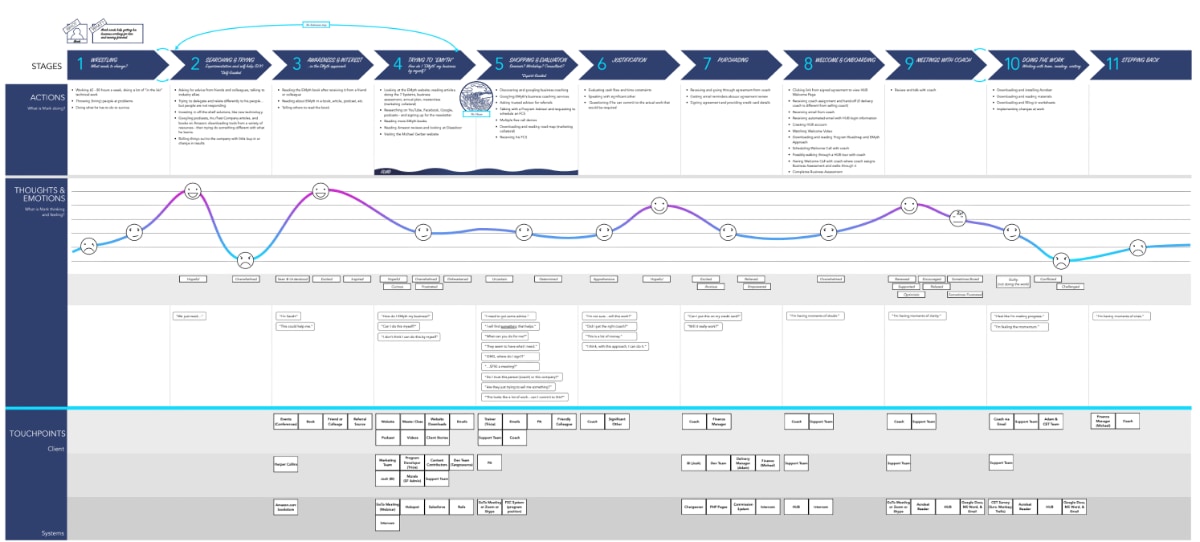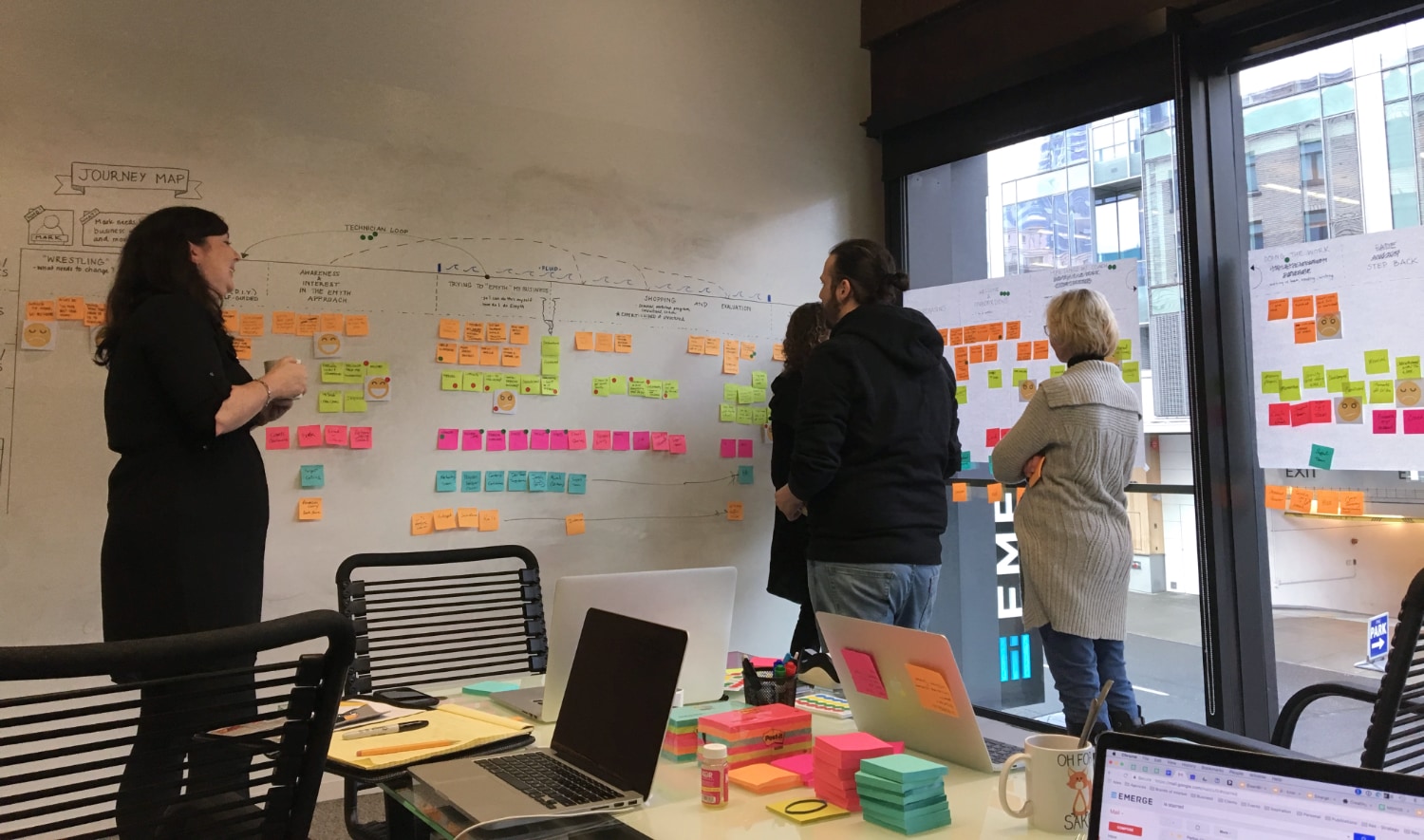
The 5 Critical Steps You Need to Create a Journey Map That Improves Customer Experience
- Product Definition /
- Product Design /
- Product Management /
You may be asking yourself what the differences are between a user, a customer, an employee, or another audience member when creating a journey map. Which journey map should you create? The answer is contingent on the degree of detail you need for your work. All users are people, and these people can be customers, employees, or other audiences your business or organization intersects with. So let’s start with understanding the single most important audience you have — the customer. Without customers, you would not have a business or organization, so understanding their experience is paramount.
Customer experience lies at the heart of everything a business or organization does. Understanding how customers engage with a brand, and what they’re feeling at different stages of their journey guides the most important decisions and strategies. It is important to recognize that the customer experience is only part of the equation.
As we’ve helped our clients map their customers’ journeys, we’ve learned that long-term success also depends on their employees’ experience just as much as their customers’ experience. It’s easy to look at a business or organization as a set of org charts, process flow diagrams, and product strategy documents. But at the core of both are people; customers and employees. Understanding what creates and defines the experiences they have with your business or organization can make or break your continued success and evolution.
Customer experience thought leader Jim Tincher once said, “When your culture focuses more on its own viewpoint than your customers’, you end up with convoluted processes, terrible return policies, and overly-complicated products.”
The interaction and engagement shaping that culture are easy enough to see in face-to-face meetings or retail sales floors. In the digital world, however, customers and employees exchange signals through systems that can enhance the customer experience or completely obliterate it.
How efficiently do those systems work? Do they pass signals to the right people at the right time? Do employees have the context and priorities they need to make the best decisions?
What is a Journey Map?
A customer journey map is a visual representation of the process a customer goes through when interacting with your business across touchpoints and channels. Mapping the customer journey allows you to see their perspective and uncover pain points and opportunities for improvement at each stage.
Journey maps do vary based on project goals and objectives, but often include:
- The different stages customers go through (e.g. awareness, consideration, purchase, post-purchase)
- Emotions customers feel during each stage
- Pain points customers experience
- Opportunities to improve customer experience
- Recommendations based on customer insights
Creating a journey map provides numerous benefits:
- Gives a big picture view of the entire customer experience lifecycle
- Aligns different teams and stakeholders around the customer perspective
- Identifies key moments of truth and prioritizes improvement efforts
- Allows you to benchmark performance at each touchpoint
- Uncovers process breakdowns and opportunities for optimization
Customer journey mapping is a powerful technique to deeply understand customer needs, frustrations, and desires. It provides actionable insights to design seamless experiences that drive loyalty and growth.

What are the 5 stages of journey mapping?
Journey mapping gives you the birds-eye view you need to answer those questions and make your company’s relationship with the customer better. It puts decisions in context so you and other company stakeholders can set shared priorities that have the biggest impact on the business.
Step 1. Define Your Audience
We’ve talked about customers and employees as audiences that are important to explore in more detail. But before you proceed any further, it’s essential to establish your audience, and where your energy and time should be focused. If you’re having trouble deciding, we suggest undertaking a service blueprint first. This process is centrally driven by customer actions but reveals touchpoints and internal and external processes involved at every step they take before, during, and after they interact with your business. These touchpoints and processes typically involve other audiences that may be worth taking the time to explore more deeply.
Chris Masanto, the CEO and co-founder of PetLab Co., says, “In building the customer journey map for PetLab Co., the defining step was understanding who our audience really is. This foundational phase wasn’t just about demographics; it was a deep dive into their behaviors, needs, and motivations. By analyzing their interactions and feedback, we crafted personas that represented our diverse customer base. This meticulous process enabled us to identify critical touchpoints and craft experiences that not only meet but exceed our customers’ expectations. By focusing on their journey from the outset, we ensured every element of our e-commerce platform was aligned with their needs, making their path to purchase not just a transaction but a meaningful experience.”
Step 2. Recruit Applicable Stakeholders
Regardless of the audience we’re talking about, your business or organization has stakeholders that understand them intimately. Take the time to find them and recruit them. You will obtain essential details from their knowledge.
The ultimate goal is to collect insights from the stakeholders that track the individual and unique steps the desired audience takes from the start of their journey to its end.
Your human resources team can be a crucial ally in this process. After all, motivating and retaining talented employees are their top priorities. Denise Lee Yohn, author of What Great Brands Do, explained in a recent Harvard Business Review article how she helped a client use employee mapping “to help… visualize and evaluate the employee journey from employees’ points of view…. to provide a seamless, engaging, and valuable employee experience.”
Need to sweeten the deal? Employee journey mapping can reveal insights that HR can use to improve their own processes.
Step 3. Create a Safe Space to Share Thoughts Freely
The key to collecting journey mapping insights is creating a safe environment where stakeholders feel comfortable sharing their thoughts and opinions about the audience. They have to trust that their input will be used to improve the business – and that their words won’t come back to haunt them.
Frequently, the first frustrations shared in these workshops are friction points in your internal processes. What information is missing? What information arrives too late to make a difference? This feedback can identify fixes and highlight improvements that could be made to your internal systems.
Why is creating a safe space so important? Ignorance frustrates top talent even more than broken processes. They want to know how their actions affect the customer and how they contribute to the organization’s success. Stakeholders also need to have actions prioritized by importance. Often, they may be pressed for time, and decisions have to be made quickly. Having go-to solutions that are vetted by the business or organization instills trust and faith that they’re doing their very best for any audience they serve.
Step 4. Connect Employee and Customer Journeys
While understanding the customer journey is crucial, you also need to map the internal employee experience that powers customer interactions. Employees directly impact the customer through their actions, decisions, and access to information. By linking customer journey maps to employee journey maps, you can identify gaps between the two experiences.
Start by overlaying customer touchpoints with corresponding employee processes. For example, map customer service calls to internal ticketing and case handling workflows. Look for mismatches between customer expectations and employee capabilities. Are employees getting the data and context they need to deliver excellent service?
Next, trace how information flows across teams and systems. Pinpoint where handoffs lead to bottlenecks or delays. Identify solutions like improved knowledge sharing, cross-training, or updated technology tools.
Finally, use insights from both maps to align priorities. Fixes that improve employee experience often also enhance customer satisfaction. Satisfied, engaged employees lead to happier customers.
Connecting customer and employee perspectives creates a powerful roadmap for change. It shows you how to transform pain points into frictionless experiences on both sides. This builds a customer-centric culture focused on your organization’s shared purpose.
Step 5. Set Your Priorities
At this point, you may have a journey map of the customer experience that identifies opportunities for improved engagement. You may also have a map of the employee experience that identifies gaps in your processes and areas of unmet potential. And if you’ve connected them, you have also created a map of the internal systems that flow signals between the two groups.
So what do you do first?
The cross-functional process that led you to this point has given you the answer: a shared set of priorities driven by your customer and employee maps. Every organization has finite resources and budgets. Use these maps as lenses to focus those resources on the fixes or new systems that will have the most significant impact on the customer.

What is a good user journey map?
A good user journey map clearly depicts the major steps and touchpoints a user interacts with when engaging with a product or service. It captures both the actions users take and the emotions they feel at each stage.
An effective user journey map:
- Follows the user path chronologically from start to finish
- Highlights key user actions and emotional states
- Identifies pain points and breakdowns in the user experience
- Visualizes complex user workflows simply and intuitively
- Connects insights to opportunities for optimization
The best journey maps focus on the user perspective and building empathy. They uncover “moments of truth” where the user experience can be enhanced to drive better outcomes.
What should a journey map include?
An effective journey map should contain the following key elements:
- Persona or target audience: Define the specific user/customer persona or target audience you are mapping to focus insights.
- User actions: Map out the step-by-step actions and processes users take during their experience.
- Emotions and mindsets: Capture how users think and feel at each stage in the journey.
- Pain points: Identify areas of frustration, confusion, or disappointment users encounter.
- Touchpoints and channels: Show the various touchpoints and channels users interact with across devices/environments.
- Opportunities: Uncover opportunities to improve user experience and business outcomes based on insights.
- Recommendations: Provide clear recommendations to optimize the user journey and address pain points uncovered in the mapping process.
- Visual narrative: Use engaging visuals and minimal text to intuitively communicate key insights from the journey mapping activity.
Including these components ensures your map captures the full context of the user experience and leads to impactful insights and improvements.
Craft a Customer Journey Map That Drives Growth
In today’s experience economy, journey mapping is essential for gaining deep customer insights that drive growth. By following the steps outlined here, you can create detailed maps of your customer lifecycle and connected employee experience. Linking these two perspectives will uncover key pain points and opportunities for improvement. Focus your efforts on changes that have the biggest impact on improving both customer and employee satisfaction.
Journey mapping is an ongoing process, not a one-time project. Continuously gather feedback and refine your maps to stay ahead of evolving needs. With a customer-centric mindset guided by journey mapping, your organization can deliver exceptional experiences that promote loyalty, advocacy and success.
The key points recap:
- Journey mapping reveals customer and employee pain points
- Connecting maps provides an outside-in view
- Identify key priorities for improvement
- Drive better experiences by understanding needs
- Journey mapping is an ongoing process
Emerge helps our clients by bringing both experience in journey mapping creation, and an impartial outsider’s perspective to the mapping process. We bridge the organizational structure with no other agenda than helping everyone succeed. Our team of creative technologists can be the friends that employees trust to voice their frustrations. And our long experience helping companies like yours lets us guide you through this journey quickly and efficiently. If your team needs assistance in creating journey maps, contact us to see how we can consult and help.